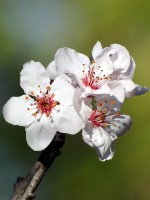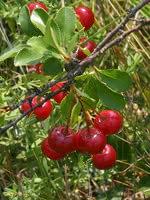Mon-Fri 9am - 5pm Mountain time
Western Sand Cherry vs Cutie Pie Sour Cherry
Prunus pumila var besseyi
Prunus cerasus Cutie Pie
NOT AVAILABLE THIS SEASON - MIGHT RETURN
NOT AVAILABLE THIS SEASON - MIGHT RETURN
Western Sand Cherry is known for its unique, leathery grey-green foliage and beautiful white blossoms. It is a popular ornamental shrub in parks and front yards. Both you and the wildlife will love its edible small dark red to purple cherries.
Due to its small stature and spreading qualities, Western Sandcherry is suitable as an underplanting or groundcover.
Many people graft plum and cherry varieties to Western Sand Cherry and use it as rootstock. It is also popular to graft hardy apricots to.
The Cutie Pie Sour Cherry produces fruit that are sweeter than other sour cherry varieties. Good for fresh eating and for making jams and jellies. They are small in stature (shrub like) and multi stemmed, which makes for a good hedge.
They are cold hardy and are a hybrid of Mongolian and European sour cherries, produced by the University of Saskatchewan.
They have small, attractive, white flowers. Cutie Pie Sour Cherry trees are self pollinating and require moist, well-drained soil. For better yields, plant compatible cultivars such as the Romeo Cherry nearby.

